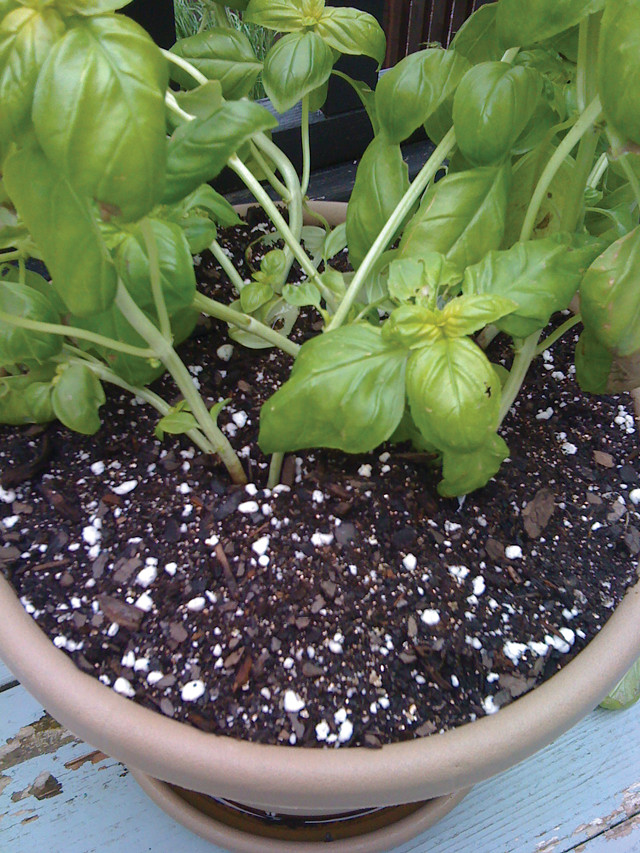
by U.S. Geological Survey Thursday, June 14, 2018
Wallace P. Bolen, a mineral commodity specialist for the U.S. Geological Survey, compiled the following information on perlite, a mineral used primarily as a lightweight aggregate in construction products.

The white particles in the potting soil are perlite. Credit: Megan Sever
Formed from viscous lava, perlite is a volcanic glass of rhyolitic composition that contains between 2 and 5 percent water. Most volcanic glasses contain some water, including obsidian (less than 1 percent) and pitchstone (up to 10 percent). Although the exact formation process for perlite is debated, it is theorized that the lava that formed perlite was deposited and cooled near the surface and hydrated over time. Pumice is closely related to perlite in composition but, because of the explosive way in which pumice forms, the rapidly cooling lava entrains air and becomes much less dense than perlite.
Perlite is mined by employing heavy machinery to rip or cut the material out of the earth, or by precise blasting. After extraction, the material is crushed and sized into marketable fractions. Then it goes to another plant where it is expanded, or “popped.” When heated, the water content of perlite reacts, and the perlite pops like popcorn. Perlite popping produces a lightweight product that is up to 40 times less dense than the original material.
In primary usage, perlite competes with other lightweight construction materials, like pumice, exfoliated vermiculite and expanded clay and shale. Each of these lightweight materials has its pros and cons, depending on the application, and each has retained certain niche markets. Perlite is especially favored in lightweight construction products, fillers for paints and joint compounds, horticultural soil blends and certain filtration applications. In addition to these primary markets, perlite is used for concrete aggregate, insulation, plaster aggregate and stone washing in laundries. In most offices or other locations with a “dropped” ceiling, the ceiling tiles are probably made primarily of perlite.
In the United States, perlite mining occurs in Arizona, California, Idaho, Nevada, New Mexico and Oregon. The U.S. share of world perlite reserves is less than 15 percent. The majority of processed crude perlite consumed in the United States is from domestic sources, but the United States imports about 25 to 30 percent of its processed perlite, mainly from Greece. Because the majority of perlite is expanded in the eastern half of the country, shipping costs from western states make it possible for Greek perlite to be competitive in the East, especially along the eastern seaboard and Gulf Coast.
For more information on perlite and other mineral resources, visit http://minerals.usgs.gov/minerals.
PERLITE PRODUCTION AND CONSUMPTION
U.S. perlite production in 2009 was estimated to be 380,000 metric tons, the lowest domestic production since 1968, likely because of the economic downturn.
Imports of processed crude perlite to the United States in 2009 were at the lowest levels since 1997.
Greece surpassed the United States in processed perlite production starting in 2003.
Perlite is mined in about 35 countries; leading producing countries over the last decade were Armenia, China, Greece, Hungary, Japan, Turkey and the United States.
FUN FACTS
Perlite received its name because of its waxy or pearly luster.
Perlite is the mineral version of popcorn, but it’s heated by a two-story high “popper” instead of a kitchen microwave or stove.
The white particles in the soil in container plants are likely perlite. Sometimes plastic particles are used in soil of potted plants. To find out if they are plastic or perlite, crush a piece. If it turns to grit, it’s perlite; if it just squishes, it’s plastic.
© 2008-2021. All rights reserved. Any copying, redistribution or retransmission of any of the contents of this service without the expressed written permission of the American Geosciences Institute is expressly prohibited. Click here for all copyright requests.